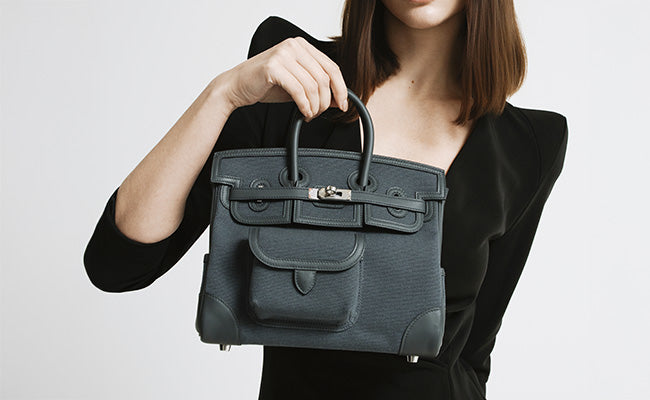
Shipping a Bag to Canada to Sell: Safety, Insurance, and Paperwork
Check out our Hermès collection and Birkin bags!
Shipping a luxury Hermes bag to Canada for resale sounds simple, but it's definitely not just a matter of sticking on a label and crossing your fingers.
Whether you're moving your collection or tapping into the Canadian appetite for ultra-luxury goods, you really need to understand the customs maze to keep your investment safe.
Proper documentation, real insurance, and following Canadian import rules are musts for shipping high-value designer bags across the border.
Get any of these wrong and, well, you could see your Birkin vanish into customs limbo, or worse, get damaged and realize you don't have coverage.
We've spent too many hours untangling the mess of international luxury shipping. From customs declarations that won't set off alarms to insurance that actually covers what your bag's worth, here's what you need for a smooth transaction.
Key Takeaways
- Accurate customs paperwork and honest valuations help avoid delays and legal headaches when importing luxury bags.
- Real insurance for high-value goods protects you if things go sideways during shipping.
- Professional packing and following Canadian sales rules help ensure your bag arrives safely and legally.
Essentials of Shipping a Luxury Bag to Canada
Sending a coveted Hermès Birkin or Kelly across the border means you need to pick the right carrier, use proper shipping methods, and insist on robust tracking. Cross-border shipping demands the kind of attention to detail that matches the bags themselves.
Selecting a Reliable Carrier for High-Value Items
When we ship luxury bags to Canada, choosing the right carrier is huge. FedEx International Priority and UPS Worldwide Express are both standouts for high-value items.
These companies offer specialized handling for luxury goods. They use climate-controlled facilities and have staff trained for premium items. You get real-time tracking and guaranteed delivery dates.
DHL Express is another solid option for international luxury shipping. Their WorldWide service adds extra security, and, in our experience, their Canadian customs clearance is pretty efficient.
Major carriers provide declared-value or insurance options, but coverage limits and terms vary. Always review the fine print or consider third-party insurance for high-value items.
Regional carriers like Purolator know Canadian luxury delivery inside and out. They get local customs requirements and their premium services cater to high-end fashion.
Full Truckload (FTL) Shipping for Premium Goods
Full-truckload (FTL) shipping is typically meant for larger cargo. For single or high-value items, consider special handling or white-glove delivery instead.
Dedicated FTL services are pricey but offer serious security. Your bags travel solo in locked, monitored vehicles. Drivers get special training for luxury goods.
Temperature-controlled FTL trucks matter, a lot. Canadian winters can be brutal on leather, so climate control is non-negotiable. These trucks keep things consistent, no matter the weather.
White glove FTL services are next-level. Drivers wear protective gear, handle items with museum-level care, and sometimes even photograph items before and after transport.
Cross-border FTL shipping needs customs paperwork ready to go. Carriers handle a lot, but you have to provide accurate descriptions and values.
Customs processing times vary widely, from a few hours to several days, depending on documentation, inspection, and carrier schedules.
Tracking and Signature Confirmation
Adult signature required services add a layer of security by making sure your bag goes to the right hands. Standard signatures can be risky, anyone at the address can accept the package.
With real-time GPS tracking, you can see exactly where your bag is, pretty much down to the hour. Some carriers have mobile apps that ping you with updates.
Photo confirmation services snap a pic at delivery, showing package condition and who received it. Good to have if questions ever come up.
Request a signature-required or ID-verified delivery option if available, requirements differ by carrier and destination This keeps strangers from picking up your package.
Canadian customs tracking links up with carrier systems, so you’ll know when your bag clears inspection. Delays happen, especially around holidays or peak shopping times.
Customs Requirements and Clearance Procedures
Shipping luxury bags to Canada means you’ll face paperwork and the Canada Border Services Agency (CBSA). Import duties and taxes are based on the bag’s declared value and classification.
Mandatory Paperwork for Cross-Border Shipments
Paperwork for shipping designer bags looks intimidating, but once you know what’s needed, it’s not too bad. You’ll need a commercial invoice that spells out the bag’s brand, model, materials, and real market value.
A detailed packing list has to go with every shipment, describing exactly what’s inside, including dimensions and weight.
The bill of lading or air waybill is your shipping receipt and contract with the carrier. Hang onto it for tracking or if there’s a dispute.
For luxury items, toss in a certificate of authenticity if you have one. It’s not mandatory, but it helps customs verify value and can keep things moving.
Key tip: Don’t undervalue luxury bags on customs forms. The CBSA knows what these things are worth, and if your numbers look off, you’ll get flagged.
Role of Canada Border Services Agency (CBSA)
CBSA is the gatekeeper for all commercial shipments into Canada. They’ll go over your paperwork, check declared values, and decide what duties apply.
CBSA officers can inspect any package, but high-value items like designer bags get extra attention. They know how to spot fakes and sketchy declarations.
Canada now uses the CARM Client Portal for commercial import entries, importers should register with a CRA Business Number and RM account to manage entries and payments.
You’ll need to register for a Business Number with an RM identifier to clear shipments.
If something seems off, CBSA can hold your shipment for manual inspection. This happens a lot with undervalued bags or missing paperwork.
Pro tip: Using a licensed customs broker can make CBSA interactions way less painful and speed up clearance.
Understanding Canadian Import Duties and Taxes
Import duty depends on the product’s HS code and country of origin.
Many leather handbag subheadings commonly fall in the single-digit to low-teens (e.g., ~8–11%), but you should check the specific tariff for your bag or ask a customs broker
GST hits all imports at 5% of the total value (item cost plus shipping plus duties). Some provinces add PST or HST, bringing total taxes up to 13-15%.
Duties are based on the transaction value, what you paid, not the retail price. This includes purchase price, shipping, and any other charges.
| Tax Type | Rate | Applied To |
|---|---|---|
| Import Duty | 0-20% | Bag value + shipping |
| GST | 5% | Total value + duties |
| PST/HST | Varies by province | Total value + duties |
You can pay up front or use a customs bond for Release Prior to Payment, but bonds need to be set up in advance.
Key Documents Needed to Ship and Sell Bags in Canada
Having the right paperwork helps your luxury bags clear Canadian customs and reach buyers without headaches. The commercial invoice, bill of lading, and Canadian customs invoice are the big three.
Commercial Invoice Details
The commercial invoice is your main document for shipping bags to Canada. Go beyond “handbag” or “purse”, be specific.
For Hermès bags, write the exact model, materials, and any manufacturing details. Instead of “purse,” use “Hermès Birkin 35cm Togo Leather Handbag.”
Must-haves on the invoice:
- Full buyer and seller contact info
- Detailed descriptions with materials and dimensions
- Item values in Canadian dollars
- Total shipment value
- Country of origin for each bag
- Harmonized System (HS) codes
Declare the true purchase price or fair market value. Lowballing the value is risky, CBSA takes it seriously.
Invoice date should match your shipping date. If you’re sending multiple bags, list each one with its own value and description.
Bill of Lading Essentials
The bill of lading is your shipping contract and receipt. It proves ownership transfer and is crucial for tracking expensive items.
It needs the right weight and dimensions for your bag shipment. If your bag has special handling needs, note that in the instructions.
What to include:
- Shipper and consignee info (should match the invoice)
- Package count and weight
- Shipping method and service level
- Special handling instructions
- Freight charges and who pays
Be clear about who’s paying for shipping. A lot of luxury bag sales use delivered duty paid (DDP) terms, so you might be covering everything.
The doc number should link to your tracking. Keep copies until your buyer confirms receipt.
Canadian Customs Invoice When Required
Shipments valued over CAD $2,500 typically require a Canada Customs Invoice (CCI). Check with your broker or carrier, most luxury bags will hit this threshold.
This document gives CBSA the details they need about your shipment. You’ll fill this out in addition to the commercial invoice.
What’s required:
- Vendor and purchaser info with addresses
- Detailed description of each bag (brand, model, materials)
- Country of manufacture for each bag
- Sale currency and payment terms
- Transportation charges broken down
You have to sign and date the customs invoice. Falsifying info here is a big deal, penalties can be severe.
Attach the invoice to the outside of your package in a clear envelope. Customs officers use it to assess duties and taxes on your sale.
Insurance and Protecting Your High-Value Bag
Shipping luxury bags to Canada without proper insurance is asking for trouble. Accurate valuation secures your compensation, and knowing the claim process helps if things go wrong.
Shipping Insurance Options for Luxury Bags
Most carriers’ basic coverage is based on weight, not value. So your $15,000 Birkin might get you a couple hundred bucks if something happens.
Third-party insurers like InsureShield or FlagShip offer coverage designed for luxury goods. They’re usually a better bet for high-value items.
Compare these types of coverage:
- Declared value insurance: Pays up to what you declare.
- Full replacement coverage: Covers the retail value.
- Door-to-door protection: Covers the whole journey.
Insurance costs are generally calculated as a percentage of the declared value, but rates depend on the insurer, destination, and shipment details.
International shipping is a different animal, standard carrier liability drops for cross-border shipments, so extra insurance is a must.
Valuation and Declaring Your Bag's True Worth
Valuing your bag right means you’re protected but not overpaying for insurance. Declare the current market value, not what you spent ages ago.
For vintage or rare pieces, check:
- Recent sales of the same bag on resale sites
- Professional appraisals
- Authentication service valuations
You’ll need: original receipts, authentication certificates, and lots of photos showing condition. Insurers look closely at luxury claims.
Under-declaring saves a few bucks on premiums, but leaves you exposed. Over-declaring can raise eyebrows and might get you investigated. Aim for accuracy.
Keep all your records, purchase price, authentication, and condition. If you need to file a claim, you’ll be glad you did.
Dealing with Delays, Damage, or Loss
If something goes wrong, act fast. Most insurers want to hear from you within 3-10 days once you notice an issue.
What to do right away:
- Take lots of photos
- Contact your insurer ASAP
- Save all packaging
- Gather receipts and tracking info
Typical claims include partial damage (scratches, stains), total loss, or theft. Each needs different documentation.
Delays don’t always mean you can claim unless you bought specific delay coverage. But longer delays can raise the risk of theft or damage.
Photograph your bag’s condition before packing and save all docs. Adjusters want proof of the bag’s pre-shipping state.
Claims usually process in 2-4 weeks for straightforward cases. Complicated luxury claims might take longer.
Preparation and Packing Techniques for Designer Bags
Getting your designer bag safely to a Canadian buyer takes careful prep, quality packing materials, and attention to the documentation details customs expects.
Secure Packaging for Transit
Start by cleaning your bag with a soft microfiber cloth, get rid of dust and fingerprints. Don’t forget hardware and the inside.
Remove detachable stuff like straps or charms. Pack these separately in small pouches so they don’t scratch the bag.
What you’ll need:
- Acid-free tissue paper (prevents color transfer)
- Bubble wrap with small bubbles (big ones can leave marks)
- Rigid cardboard box, 5-10cm larger than the bag
- Biodegradable air pillows for filling gaps
- Tamper-evident tape for security
Wrap the bag in its original dust bag or acid-free tissue. The tissue keeps hardware from scratching the leather.
Put the wrapped bag in the center of the box. Use air pillows to fill empty space so nothing moves. Give the box a gentle shake, if it rattles, add more padding.
Double boxing: For bags over $2,000, put the first box inside a larger one with extra cushioning between them.
Labelling and Documentation Best Practices
Canadian customs expects pretty specific paperwork for designer bags, especially if they're valued above $1,000 CAD. If we skip details, we risk delays or surprise fees.
Here’s what you’ll need:
- A commercial invoice describing the bag exactly as it is
- Proof of purchase or an authentication certificate
- Details about what it’s made of (leather type, hardware)
- Where it was made
Mark the box exterior with "FRAGILE - LUXURY LEATHER GOODS" in big, bold letters. Both sender and recipient info, don’t forget those postal codes, should be easy to find.
We always declare the full market value, even if we paid less. If customs finds out we undervalued, they can fine us and hold things up for ages.
Pro tip: Tuck some photos of the bag’s condition inside the box. If you ever need to file an insurance claim, those shots are your best friend.
Make an inventory sheet that lists everything: bag, dust cover, authentication cards, original packaging. Customs likes to see what’s inside without digging around too much.
Avoiding Common Packing Mistakes
Honestly, the number one blunder? Using newspaper as padding. The ink rubs off and ruins light-colored leather for good.
Don’t pack multiple bags in one box. Even if you think you’ve protected them, zippers and hardware can scratch up neighboring bags when things get jostled around.
Packing mistakes to steer clear of:
- Overstuffing boxes (creates pressure spots)
- Packing peanuts (they settle, leaving empty gaps)
- Wrapping bags directly in plastic (traps moisture)
- Not enough padding around hardware
Vacuum-sealing leather? Just don’t. It flattens and creases the bag, and leather needs space to breathe.
For temperature-sensitive bags, especially exotic leathers like crocodile or python, we avoid shipping during harsh Canadian winters. Cold can crack the leather.
Keep an eye on weight limits. Canada Post and couriers can tack on overweight fees, sometimes over $100 for designer bags.
Compliance, Prohibited Items, and Sales Regulations
Canada’s import rules and sales laws are strict, especially for luxury bags. If we don’t get the paperwork and compliance right, we could face delays or worse.
Reviewing Restricted and Prohibited Imports
Canada controls what comes across the border to protect health, safety, and the environment. When shipping luxury bags for resale, we need to make sure nothing falls into restricted categories.
Some commonly restricted items:
- Leather goods from certain countries
- Items with endangered species materials
- Products with counterfeit parts
- Goods under anti-dumping rules
Hermès bags are usually fine, but vintage pieces can be tricky. Exotic leathers, crocodile, alligator, anything protected, need CITES permits even if they’re authentic.
If we don’t comply, customs can seize the bag. That means fines or even prosecution, which is obviously not worth it.
Depending on what the bag’s made of and where it’s from, we might need an import permit. It’s smart to check the Automated Import Reference System before shipping.
Sales Requirements and Regulatory Considerations
Selling luxury imports here means following consumer protection laws and tax rules. If we sell over $30,000 a year, we have to register for a GST/HST account.
Provincial sales taxes are all over the place. Ontario takes 13% HST, Alberta wants just 5% GST. It’s on us to know what’s required where we sell.
Consumer protection laws demand honest product descriptions and authenticity guarantees. If we fudge the bag’s age or condition, the Competition Act could hit us with big penalties.
We’ve got to keep good records, receipts, customs forms, sales transactions. The Canada Revenue Agency can audit us for up to four years.
Business licensing depends on province and how much we’re selling. Some places want retail permits for luxury sales, others have rules for high-value items.
Frequently Asked Questions
Shipping a luxury Hermès bag to Canada isn’t just about a sturdy box. There’s authentication, special packaging, customs forms, and insurance, each step matters if you want things to go smoothly.
How can I ensure the authenticity of my Hermès bag when shipping internationally for resale?
Customs wants proof. Hang onto your original receipt, authenticity cards, and any certificates from legit authentication services.
Services like Entrupy or Real Authentication give you digital certificates, customs trusts these more than just your word.
Take lots of photos: hardware, serial numbers, stitching, the works. If customs or your insurer asks questions, you’ll have backup.
What's the most secure way to package a luxury bag to withstand international travel?
Double-boxing is the way to go. Put the Hermès box inside a bigger shipping box. Fill gaps with acid-free tissue paper so nothing moves.
Pick a tough outer box,double-wall construction is best. Use bubble wrap or foam for cushioning. Customs workers handle a mountain of packages, so expect some roughness.
Seal every seam with strong packing tape and reinforce the corners. If you’re worried about moisture, wrap the inner box in waterproof plastic.
Could you guide me through the customs process when shipping designer bags to Canada?
Every shipment needs a customs declaration: real value, description, and purpose. Declare the bag’s market value, not what you paid ages ago.
Customs may charge duties and GST/HST based on what the bag’s worth now. Hermès bags can go up in value, so expect taxes on today’s price.
A customs broker can prep documents and submit everything electronically. For high-end bags, they’re worth it, they’ll calculate duties and handle clearance.
What's the deal with insurance for high-end bags in transit? Worth the pretty penny or not?
Insurance is a must for bags worth thousands. Basic carrier coverage is usually just $100-200, barely a drop in the bucket for a Birkin.
Get declared value insurance for the bag’s current market price. It’s about 1-3% of the value, but covers loss, theft, or damage.
Insurers want proof: value documents, photos, and authentication. Without these, even insured claims can get denied.
Are there any specific couriers that specialize in the safe transport of luxury goods to Canada?
FedEx and UPS both offer premium services for high-value stuff, extra tracking, security, signatures, the works.
DHL Express has white-glove handling and customer service that actually understands luxury items.
There are even boutique shippers who only handle luxury goods. They’ll use tamper-evident packaging and GPS tracking. It’s pricier, but if you’re nervous, it can be worth every penny.
What's the paperwork protocol to prevent my posh parcel from being delayed at Canadian borders?
Customs forms need clear details, think bag material, color, size, and whether you're reselling. Just calling it a "leather handbag"? That'll probably get it flagged for more checks.
You'll want a commercial invoice that lays out the transaction value and why you're shipping it for business. Declaring it as a personal gift won't cut it for Canadian resale.
Hang onto your records, paper or digital, for at least six years after you import. Even if a customs broker takes care of things, it's smart to keep your own copies on hand.




